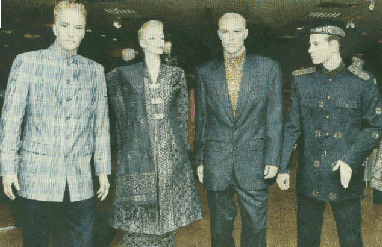The tie is old hat
Dato' Dzulkifli Abd Razak
Article
- Comment - New Sunday Times - 04/23/2006
WHAT’S in a tie. Plenty, going by recent events. First, the Canadian Parliament. Some years ago, I watched a televised Canadian session where a member of the House was not allowed to speak because he wore a turtleneck sweater and did not have a tie on.
The quick thinking member borrowed a tie from his colleague and fixed it over the turtleneck and was allowed to speak.
This Canadian incident illustrated the point that a piece of cloth tied around the neck is accorded such importance.
There was a "Canadian" affair in the Malaysian Parliament recently involving a Minister. Although not as dramatic as the Canadian incident, the implication was similar.
The crux of the issue: Should a tie be accorded such importance?
Perhaps it is timely to throw some perspective on the so-called "alternative" outfit in reference to what the Culture, Arts and Heritage Minister wore — a collarless shirt with buttons right up to the neck that did not require a tie.
How apt. He was presenting the Akademik Seni Budaya Warisan Kebangsaan 2006 Bill when some members voiced objection to his attire.
Article
- Comment - New Sunday Times - 04/23/2006
WHAT’S in a tie. Plenty, going by recent events. First, the Canadian Parliament. Some years ago, I watched a televised Canadian session where a member of the House was not allowed to speak because he wore a turtleneck sweater and did not have a tie on.
The quick thinking member borrowed a tie from his colleague and fixed it over the turtleneck and was allowed to speak.
This Canadian incident illustrated the point that a piece of cloth tied around the neck is accorded such importance.
There was a "Canadian" affair in the Malaysian Parliament recently involving a Minister. Although not as dramatic as the Canadian incident, the implication was similar.
The crux of the issue: Should a tie be accorded such importance?
Perhaps it is timely to throw some perspective on the so-called "alternative" outfit in reference to what the Culture, Arts and Heritage Minister wore — a collarless shirt with buttons right up to the neck that did not require a tie.
How apt. He was presenting the Akademik Seni Budaya Warisan Kebangsaan 2006 Bill when some members voiced objection to his attire.

Proposed alternative attire for official function
But as the minister clarified, in a vernacular newspaper, the outfit had the approval of the Cabinet in February, and the Speaker of the House on that day had no objection. The menteris besar and chief ministers who met last month had also no objection to such an outfit.
Apart from the current regulations, the outfit also raises the question of cultural pride and heritage that the Culture, Arts and Heritage Ministry has to embody as an exemplar. After all, dressing is always central to any culture and heritage.
Recall for example the Apec summits where all heads of state wore outfits of the host country at certain functions.
Although this was just a symbolic gesture, it gave importance to the identity of a culture. Such dressing is not limited to just official functions — the wearing of batik in public offices twice a month is a case in point.
One will also recall how the charismatic Nelson Mandela stood tall in his batik-like long sleeves at many international functions while the rest sported the usual business suit and tie.
It was the same with Tan Sri Razali Ismail when he presided over the United Nations General Assembly not too long ago. He could have opted for the business-as-usual code of dressing.
It may be argued that the baju melayu is an alternative outfit already allowed in Parliament. The fact remains that although the baju melayu is linked to one community, it is regarded by all as a national outfit.
The tudung and songkok, despite all the publicity for and against it, are also part of the national dress. One would be pleasantly surprised if individuals from other communities wear it on Friday, or if Cabinet members do it regularly to make a statement. The irony is, of course, while some may consider the baju melayu an "ethnic" outfit, they would rather wear lounge suits and ties on a hot and humid Malaysian day. And they also pay more for such outfits.
The baju melayu is an elite form of dressing that is acceptable in high places, especially among socialites. So it makes sense that there should be an alternative outfit that Malaysians can easily identify with.
The one that the minister wore in Parliament seems to fit the bill. It also portrays a shared heritage among many Malaysian communities, unlike the suit and tie.
In other words, there is no reason why a tie must be made mandatory, especially in such an august body as Parliament.
Indeed, there are increasingly many communities worldwide who have forsaken the "colonial knot" in preference for traditional wear.
The collar a la cekang musang style, as a case in point, is not alien to mainstream Malaysian communities be they in the peninsula or Sabah or Sarawak.
The style is sufficient to invoke tradition in each of the cultures. In addition, it also has an international appeal even as designer wear, as seen in many high-end fashion houses.
It is a uniquely affordable Malaysian design and style suited for everyday use.
